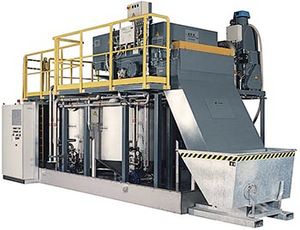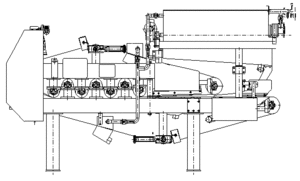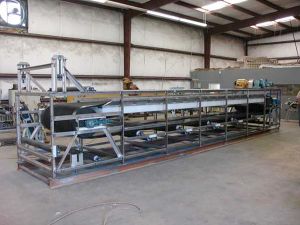Difference between revisions of "Belt Filters"
(Created page with "Category:Filtration{{Knoppen}} <noinclude><!------------------------------------------------ * READ THIS FIRST * Only edit this page if you can improve the content. * Improp...") |
|||
| (4 intermediate revisions by 2 users not shown) | |||
| Line 1: | Line 1: | ||
[[Category:Filtration]]{{Knoppen}} | [[Category:Filtration]]{{Knoppen}} | ||
[[File:Belt_filters_01.jpg|thumb|right|Belt filter]] | |||
[[File:Belt_filters_02.gif|thumb|right|Belt filter working model]] | |||
[[File:Belt_filters_03.jpg|thumb|right|Horizontal belt filter]] | |||
The '''Belt Filter''' (sometimes called a belt [[Filter Presses|filter press]]) is an industrial machine, used for solid/liquid separation processes, particularly the dewatering of sludges in the chemical industry, mining and water treatment. The process of filtration is primarily obtained by passing a pair of filtering cloths and belts through a system of rollers. | |||
* | |||
==Operation== | |||
The feed sludge to be dewatered is introduced from a [[Hoppers|hopper]] between two [[Filter Cloths|filter cloths]] (supported by perforated belts) which pass through a convoluted arrangement of rollers. As the belts are fed through the rollers, water is squeezed out of the sludge. When the belts pass through the final pair of rollers in the process, the filter cloths are separated and the filter cake is scraped off into a suitable container. A belt filter is generally used in phosphatic fertiliser plants to separate the solid from slurry. It comprises washing to different zone to minimise the product losses. Belt filters use a vacuum system to minimise offgas and effluent during operations. It has applications in many other areas of industry. | |||
==Improvements== | |||
The effectiveness of the operation can be increased by creating a pressure difference across the filter cloth. The filter cloth is directed though a zone where either pressure or vacuum pushes water from the filter cloths and ultimately to drain. | |||
The sludge can be combined with a filter aid or flocculant the help the filtration process and reduce blinding of the filter cloth. | |||
Filter cloths can be cleaned throughout the operation of the process by means of water sprays positioned on the return section of the belt. | |||
==Related topic== | |||
*[[Vacuum Belt Filters]] | |||
==Video== | |||
<youtube>lXH5_udnDg0</youtube> | |||
==Sources== | |||
* [http://en.wikipedia.org/wiki/Belt_filter Wikipedia belt filters] | |||
Latest revision as of 11:48, 23 March 2013
The Belt Filter (sometimes called a belt filter press) is an industrial machine, used for solid/liquid separation processes, particularly the dewatering of sludges in the chemical industry, mining and water treatment. The process of filtration is primarily obtained by passing a pair of filtering cloths and belts through a system of rollers.
Operation
The feed sludge to be dewatered is introduced from a hopper between two filter cloths (supported by perforated belts) which pass through a convoluted arrangement of rollers. As the belts are fed through the rollers, water is squeezed out of the sludge. When the belts pass through the final pair of rollers in the process, the filter cloths are separated and the filter cake is scraped off into a suitable container. A belt filter is generally used in phosphatic fertiliser plants to separate the solid from slurry. It comprises washing to different zone to minimise the product losses. Belt filters use a vacuum system to minimise offgas and effluent during operations. It has applications in many other areas of industry.
Improvements
The effectiveness of the operation can be increased by creating a pressure difference across the filter cloth. The filter cloth is directed though a zone where either pressure or vacuum pushes water from the filter cloths and ultimately to drain. The sludge can be combined with a filter aid or flocculant the help the filtration process and reduce blinding of the filter cloth. Filter cloths can be cleaned throughout the operation of the process by means of water sprays positioned on the return section of the belt.
Related topic
Video


